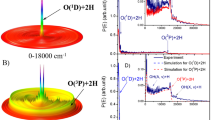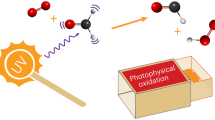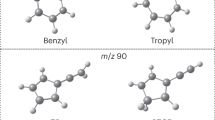Abstract
In the formation of ozone from O and O2 in the ground state, the products of the reaction may include electronically excited forms of ozone (O*3) which are spectroscopically recognizable in pulsed radiolysis and flash photolysis experiments1–4. Indeed, it has been suggested that in the three-body recombination reaction O+O2+M→O*3+M(1) there is a 62% chance that the ozone product will be in an excited form. Although the identity of these excited precursors of ozone is not known, excited 3B2, 3A2 and 1A2 states of bent ozone and the cyclic ozone have been suggested5–7, and the existence of electronically excited states of bent ozone below its dissociation limit has been corroborated by large-angle electron scattering experiments8. Thus, more than one form of internally excited ozone precursor may be involved. It has been estimated9 that ∑n(O*3) ≈ (100–1,000) · n (O1D) in the stratosphere. Consequently, even with moderate reactivity, O*3 may be chemically significant in the stratosphere. We now hypothesize that some of the internally excited ozone, probably that which is electronically excited, may be a potential source of N2O through the gas-phase reacton (2a), O*3 + N2→N2O + O2 (2a) →O3 + N2 (2b)
This is a preview of subscription content, access via your institution
Access options
Subscribe to this journal
Receive 51 print issues and online access
$199.00 per year
only $3.90 per issue
Buy this article
- Purchase on Springer Link
- Instant access to full article PDF
Prices may be subject to local taxes which are calculated during checkout
Similar content being viewed by others
References
Riley, J. F. & Cahill, R. W. J. chem. Phys. 52, 3297 (1970).
Bevan, P. L. T. & Johnson, G. R. A. JCS Faraday Trans. I. 69, 216 (1973).
von Rosenberg, C. W. & Trainer, D. W. J. chem. Phys. 63, 5348 (1980).
Kleindienst, T., Locker, J. R. & Bair, E. J. J. Photochem. 12, 67 (1980).
Wraight, P. C. Planet. Space Sci. 25, 1177 (1977).
Hay, P. J., Dunning, T. H. & Goddard, W. A. III Chem. phys. Lett. 23, 457 (1973).
Wright, J. S. Can. J. Chem. 51, 139 (1973).
Swanson, N. & Cellota, R. J. Phys. Rev. Lett. 35, 783 (1975).
Prasad, S. S. & Burton, P. G. Planet. Space Sci. 27, 411 (1979).
Bates, D. R. & Witherspoon, A. E. Mon. Not. R. astr. Soc. 112, 101 (1952).
Bates, D. R. & Hays, P. B. Planet. Space Sci. 15, 189 (1967).
Sinel'nikova, G. Ye Atmos. Ocean Phys. 12, 106 (1976).
Goody, R. M. & Walshaw, C. D. Q. Jl R. met. Soc. 79, 496 (1953).
DeMore, W. B. & Raper, O. F. J. chem. Phys. 37, 2048 (1962).
Lin, C. L. & DeMore, W. B. J Photochem. 2, 161 (1973/1974).
Jones, I. T. N. & Wayne, R. P. Proc. R. Soc. A319, 273 (1970).
Kuis, S., Simonaitis, R. & Heicklen, J. J. geophys. Res. 80, 1328 (1975).
Simonaitis, R., Braslavisky, S., Heicklen, J. & Nicolet, M. Chem. phys. Lett. 19, 601 (1973).
DeMore, W. B. & Raper, O. F. J. chem. Phys. 44, 1780 (1966).
Simonaitis, R., Lissi, E. & Heicklen, J. J. geophys. Res. 77, 4248 (1972).
Shimazaki, T., Ogawa, T. & Farrell, B. C. NASA Tech. Note TN D-8399 (NASA, Washington DC 1977).
Stratospheric Ozone Depletion by Halocarbons: Chemistry and Transport (US National Academy of Sciences, Washington DC 1979).
Farmer, C. B., Raper, O. F., Robbins, B. D., Toth, R. A. & Muller, C. J. geophys. Res. 85, 1621 (1980).
Levy, H. II, Mahlman, J. D. & Moxim, W. J. Geophys. Res. Lett. 6, 155 (1979).
Weiss, R. F. & Craig, H. Geophys. Res. Lett. 3, 751 (1976).
Author information
Authors and Affiliations
Rights and permissions
About this article
Cite this article
Prasad, S. Excited ozone is a possible source of atmospheric N2O. Nature 289, 386–388 (1981). https://doi.org/10.1038/289386a0
Received:
Accepted:
Issue Date:
DOI: https://doi.org/10.1038/289386a0
This article is cited by
Comments
By submitting a comment you agree to abide by our Terms and Community Guidelines. If you find something abusive or that does not comply with our terms or guidelines please flag it as inappropriate.



